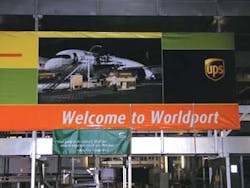Worldport: What Brown Does for Green
Landing at Louisville International Airport, the UPS Worldport facility makes a distinct impression. The white walls of the miles-long facility come into a view punctuated by the unmistakable brown logo on the plane tails. The facility is monstrous, featuring 5.2 million square feet of space, including about 300 acres of ramp space — every bit of which is utilized for the formidable task at hand.
The Operation
Offering a service based on timeliness that affords little room for error, the facility runs with a type of precision that generates numerous impressive statistics. It processes 416,000 packages an hour, or 1.2 million packages a day, which increases to more than 2 million packages a day during peak season.
Worldport features 155 miles of conveyor belts. Each package is only touched twice — loading and unloading — and travels through the facility in approximately 13 minutes, with camera imaging to automatically read labels and sort packages into appropriate bins for loading.
The “wings” of the facility have the ability to facilitate 70 docked aircraft and about 65 aircraft parked away from the facility. The crews turn approximately 125 flights each day, with the most flight activity taking place just after midnight.
Like many others, UPS has felt a decline in cargo volumes which has affected the bottom line. According to its 2009 annual report, the company saw a decline in revenue of about 12 percent from 2008 to 2009, due to lower volumes in U.S. domestic package, international package, and supply chain and freight segments. The report did cite improvements in volume for those segments in the fourth quarter of 2009, indicating an overall upswing and more positive outlook for 2010.
And as volumes recover, the facility will be ready.
GSE: The Purchase Process
Of course, preparation cannot be complete without proper support on the ramp. That support comes in the form of 4,000 pieces of non-powered GSE and 2,000 pieces of powered GSE, as well as the more than 100 employees of the GSE department.
According to Bill Jacob, vice president of airline ground support equipment at UPS, the airline owns units from nearly every manufacturer.
When it comes to the acquisition process, it involves sending RFQs to approved vendors. To be placed on an approved vendor’s list, an OEM must go through a six-month test period, which is followed by a final test that a manufacturer must pass.
UPS also has a GSE engineering team of three individuals that work with manufacturers to “build” equipment, or work with the OEMs to tailor the specs to their specific needs.
“Up to this year our purchasing was done on an expansion basis, as we were growing. The contraction hit us, and we had very small builds in 2008 and 2009, all we needed was build equipment for international,” he says.
According to Jacob, the company will make investments in new GSE as the economy recovers.
Maintenance records have also played an important part in purchasing. Jacob says the UPS GSE team has kept strict record of maintenance figures to tally the complete cost of ownership for each manufacturer type. “Reliability is the utmost with us,” he says. “When you promise a package by 8:30 in the morning, and are willing to pay the customer for that package if it misses service, you have to make sure you do what you promise.”
He adds, “We can trace every breakdown and every delay back to a cause type, or operation of a unit. We use that data to share with the manufacturers and say, ‘yes, we are going to buy your loaders, your GPUs, because they’ve shown this percentage of reliability for us, or not because we don’t see the cost of ownership we expect to see.’”
With so many pieces of GSE in operation at Worldport, maintenance has played a vital role in ensuring equipment is ready. The fleet is tracked through the Automotive Information System, the same system as its delivery fleet. The work is split between mechanics — 60 mechanics for powered equipment and 18 mechanics for nonpowered GSE — and equipment is maintained onsite at the company’s GSE maintenance shop.
“Each mechanic owns a fleet of around 50 tugs, or 14 loaders, or 40 GPUs. They’re responsible for that fleet, and all the maintenance on that fleet,” Jacob explains.
All mechanics have been certified in preventive maintenance inspections for their assigned type of vehicle. The maintenance area has a separate shop in which the time to complete a maintenance task is recorded and then figured into the overall scheduling.
To ensure the work is not interrupted, the company has an inventory of between $400,000 and $500,000 in parts value.
Environmental Focus
UPS has been quite vocal about its intention to mitigate the environmental impact of its overall operations — recently announcing in its 2009 sustainability report that it aims to reduce the emissions of its delivery fleet 20 percent by 2020.
GSE has played no small part in the company’s environmental ambitions. To achieve company goals, electric loaders have been installed at each loading dock on the wings, along with 400 Hz power GPUs.
The company has also taken on the repowering of 92 tugs with cleaner gasoline engines through an EPA grant, a project that is still underway at Worldport.
UPS also began another repowering project in California, with more than 100 of its tugs getting repowered to newer, lower-emission gasoline engines, according to Jacob. UPS is also one of eight airlines that signed an agreement for the use of synthetic renewable diesel in its GSE at LAX when it becomes available sometime in 2012.
Believing the appearance of equipment is a reflection on the operation as a whole, UPS also performs paint and body repairs on its units to keep them looking good. In fact, one would likely not suspect the age of a tug in operation since the 1980s, except for its 3-digit identification number.
Investment in Employees
With operations running at a hectic pace at times, safety has remained a top priority. For GSE operators, the company has run an internal certification program, which is recurrent every three years.
Also, safe and secure practices have been ingrained in the working culture through daily activities, including the requirement that airside drivers honk twice at each stop. Every meeting held at the facility also begins with a “safety first” tip.
The company has also invested in its employees through internal promotions and an education program that allows employees to pursue higher education. Some courses even take place on the Worldport grounds.
The investments made in ground support equipment and employees have played a critical part to the operation at Worldport, Jacob says. “It’s a very efficient facility,” Jacob says. “But you have got to feed it. That’s where GSE comes in. Without the people and equipment, the planes don’t fly.”
UPS Worldport at a Glance
Size of Sort Hub Facility: 5.2 million square feet
Air Sort Capacity: 416,000 packages/documents per hour
Ramp Size: 300 acres with 135 aircraft parking positions
Average Number Daily UPS Flights: More than 237 in/outbound flights
Geographic Area Served: More than 200 countries and territories worldwide
Freight facility: 654,000 square feet
Powered GSE: about 2,000
Nonpowered GSE: about 4,000

